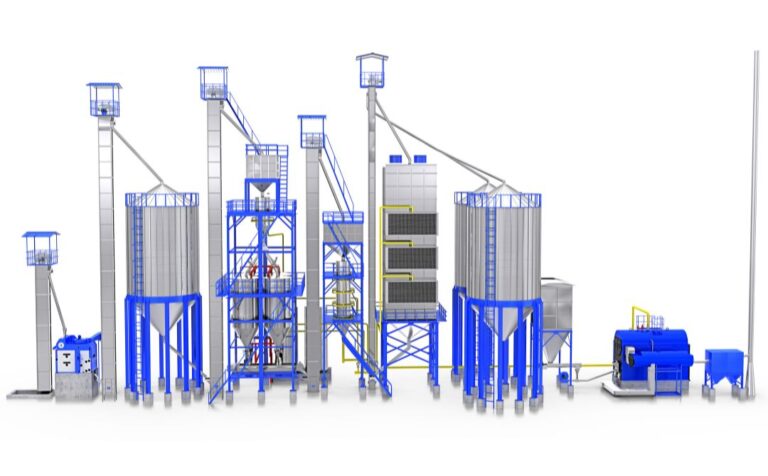Table of Contents
Rice, a cornerstone of Indian agriculture and cuisine, supports millions of livelihoods and fuels a ₹5 lakh crore industry. As consumer preferences shift toward premium, aged rice varieties known for their distinct flavor and texture, the demand for advanced processing techniques is soaring.
Steam rice processing, a specialized method that enhances grain quality, is gaining traction among rice manufacturers aiming to capture both domestic and export markets.
At SKF Elixer, we empower millers with cutting-edge steam rice processing plants, designed to deliver high-quality aged rice with efficiency and precision tailored for India’s diverse agricultural needs.
This blog explores the intricacies of steam rice processing, its advantages over traditional methods, and how SKF Elixer’s innovative plants drive profitability and sustainability. Whether you’re a miller in Punjab, a cooperative leader in Tamil Nadu, or an entrepreneur in Uttar Pradesh, our insights will guide you toward leveraging steam rice production for success.
The Rising Demand for Aged Rice in India
Aged rice, prized for its fluffy texture, enhanced aroma, and longer shelf life, commands premium prices of ₹60–₹100 per kilogram in domestic and export markets. India’s parboiled and aged rice exports contribute ₹50,000 crore annually, with steam processing playing a pivotal role in meeting global quality standards.
Traditional raw rice processing often results in 3–5% grain breakage (150–250 kilograms per 5 tonnes, worth ₹7,500–₹12,500 at ₹50 per kilogram) and inconsistent quality. Steam rice processing, by contrast, improves head rice recovery to 95–97%, adding ₹20,000–₹30,000 per 10 tonnes in value.
Steam rice processing plants use advanced paddy steaming technology to produce aged rice that meets Food Safety and Standards Authority of India (FSSAI) standards, ensuring superior quality and profitability for rice manufacturers.
Introduction to Steam Rice and Its Growing Demand
Steam rice processing involves subjecting paddy to high-pressure steam before drying and milling, a method that enhances grain strength, nutritional retention, and sensory qualities. Unlike raw rice, which is milled directly from dried paddy, steam rice undergoes controlled steaming to gelatinize starch, resulting in firmer, non-sticky grains ideal for premium dishes like biryani and pulao.
The process aligns with the growing consumer preference for aged rice, which absorbs more water during cooking, yielding 20–30% more cooked volume per kilogram.
The demand for steam-processed aged rice is surging, particularly in urban markets and export destinations like the Middle East, where India exports 4 million tonnes annually. For a 50-tonne-per-day mill, producing steam rice can boost revenue by ₹2–3 crore annually due to higher market prices and export potential.
Step-by-Step Process in a Steam Rice Plant
Steam rice processing plants streamline production with precision:
1. Pre-Cleaning
Paddy is cleaned to remove debris (1–2 kilograms per tonne) using stainless steel sieves, preventing contamination and ensuring hygiene. For a 10-tonne batch, this saves ₹5,000–₹10,000 in grain losses.
2. Soaking
Paddy is soaked in hot water (70–80°C) for 1–3 hours to achieve 30–35% moisture content, softening the grain for steaming. Stainless steel tanks maintain uniform temperature, reducing energy costs by ₹10,000–₹15,000 per 10-tonne batch compared to traditional methods.
3. Paddy Steaming Technology
High-pressure steam (1–3 kg/cm²) is applied for 10–20 minutes, gelatinizing starch and driving nutrients into the endosperm. This strengthens grains, reducing breakage to below 1% and achieving 95–97% head rice recovery, worth ₹20,000–₹30,000 per 10 tonnes.
4. Drying
Steamed paddy is dried to 12–14% moisture using hot air (40–50°C) in automated dryers, taking 6–8 hours for a 5-tonne batch. This prevents spoilage, saving ₹20,000–₹30,000 per batch compared to sun-drying’s 5–10% losses.
5. Milling
Dried paddy is milled, with stainless steel components ensuring clean, contamination-free rice, adding ₹5–10 per kilogram in market value.
Plants integrate IoT sensors for real-time temperature and moisture control, ensuring consistency across batches.
Advantages of Steam Rice Over Raw Rice
Steam rice offers significant benefits:
- Enhanced Quality: Firmer grains with 95–97% head rice recovery increase market value by ₹5–10 per kilogram, adding ₹2–3 crore annually for a 50-tonne-per-day mill.
- Nutritional Retention: Steaming retains 80–90% of thiamine (0.4–0.6 mg/100g) and iron (2–3 mg/100g), reducing deficiency risks and healthcare costs by ₹2,000–₹5,000 annually for a family consuming 10 kilograms monthly.
- Longer Shelf Life: Pest resistance extends storage by 6–12 months, saving ₹10,000–₹20,000 per 10 tonnes in losses.
- Cooking Efficiency: Yields 20–30% more cooked volume, reducing preparation costs by ₹500–₹1,000 annually per household.
- Export Appeal: Meets global standards, boosting parboiled rice exports by ₹50,000 crore annually.
Machinery and Technology Used in Steam Rice Plants
Steam rice plants incorporate advanced technology:
- Stainless Steel Steamers: Food-grade SS304 ensures hygiene and corrosion resistance, lasting 15–20 years and saving ₹10–15 lakh in replacements compared to mild steel.
- High-Pressure Boilers: Generate steam at 1–3 kg/cm², consuming 50–80 kilograms of husk per tonne (₹500–₹800 at ₹10 per kilogram), saving ₹1–2 lakh annually in fuel costs.
- IoT-Enabled Controls: Monitor temperature and moisture, reducing energy use by 20–30% (₹1–2 lakh annually for a 10-tonne-per-day plant).
- Automated Dryers: Handle 5–10 tonnes per batch, ensuring uniform drying and saving ₹20,000–₹30,000 per batch in losses.
These features ensure compliance with FSSAI and export standards, enhancing operational efficiency.
Investment and Profitability of Steam Rice Processing
Investing in a steam rice processing plant involves:
- Steam Rice Plant Cost: Small-scale plants (5–10 tonnes per day) cost ₹20–30 lakh, while large-scale plants (20–50 tonnes per day) start at ₹60 lakh. Subsidies under PM Kisan Sampada Yojana could offset 20–30% of costs.
- Operating Costs: ₹50,000–₹1 lakh annually for a 10-tonne-per-day plant, including fuel (husk at ₹10 per kilogram) and maintenance.
- Profitability: Higher head rice recovery and premium pricing (₹5–10 per kilogram) yield ₹2–3 crore annually for a 50-tonne-per-day plant. Reduced losses (below 1%) save ₹50,000–₹1 lakh daily for a 20-tonne-per-day mill.
- Return on Investment (ROI): Breakeven within 2–3 years, with AMCs starting at ₹50,000 per year ensuring 98% uptime.
SKF Elixer’s Steam Rice Processing Solutions
Our plants cater to diverse needs:
- Small-Scale Mills: 5–10-tonne-per-day plants occupy 150–200 square meters, saving ₹50,000–₹1 lakh annually in labor, ideal for cooperatives in Tamil Nadu.
- Large-Scale Mills: 20–50-tonne-per-day systems yield ₹2–3 crore annually in higher output for manufacturers in Punjab.
- Smart Features: IoT controls and stainless steel components reduce energy costs by 20–30%, saving ₹1–2 lakh annually for a 10-tonne-per-day plant.
Why Choose SKF Elixer?
With over a decade of expertise, SKF Elixer delivers BIS-certified steam rice processing plants tailored for India’s rice varieties. Our options, support, and AMCs ensure reliability, making us a trusted partner for rice manufacturers.
Conclusion
Steam rice processing plants elevate aged rice production, delivering superior quality, nutrition, and market value. SKF Elixer’s advanced systems ensure efficiency, sustainability, and profitability for India’s rice industry.
Choose our solutions to meet the growing demand for premium rice.
Ready to transform your rice production? Contact SKF Elixer to explore our steam rice processing plants.
FAQs
-
1. What is steam rice, and why is its demand growing?
Steam rice is produced by steaming paddy to gelatinize starch, enhancing texture and nutrition. Its demand is rising due to premium pricing (₹60–₹100/kg) and export potential (₹50,000 crore annually), driven by consumer preference for aged rice.
-
2. What is the step-by-step process in a steam rice plant?
It includes pre-cleaning (1–2 kg impurities per tonne), soaking (70–80°C), steaming (1–3 kg/cm²), drying (12–14% moisture), and milling. These plants save ₹20,000–₹30,000 per 10-tonne batch in losses.
-
3. What are the advantages of steam rice over raw rice?
Steam rice offers 95–97% head rice recovery (₹20,000–₹30,000 per 10 tonnes), 80–90% nutrient retention, and 6–12 months longer shelf life, saving ₹10,000–₹20,000 per 10 tonnes in storage losses.
-
4. What machinery and technology are used in steam rice plants?
These plants use stainless steel steamers, high-pressure boilers (50–80 kg husk per tonne, ₹500–₹800), and IoT controls, reducing energy costs by 20–30% (₹1–2 lakh annually for 10 tonnes/day).
-
5. What is the investment and profitability of steam rice processing?
Plants cost ₹20–60 lakh, with ₹50,000–₹1 lakh annual operating costs. They yield ₹2–3 crore annually for a 50-tonne-per-day mill, with breakeven in 2–3 years, supported by 20–30% subsidies.
Good reads are meant to be shared









